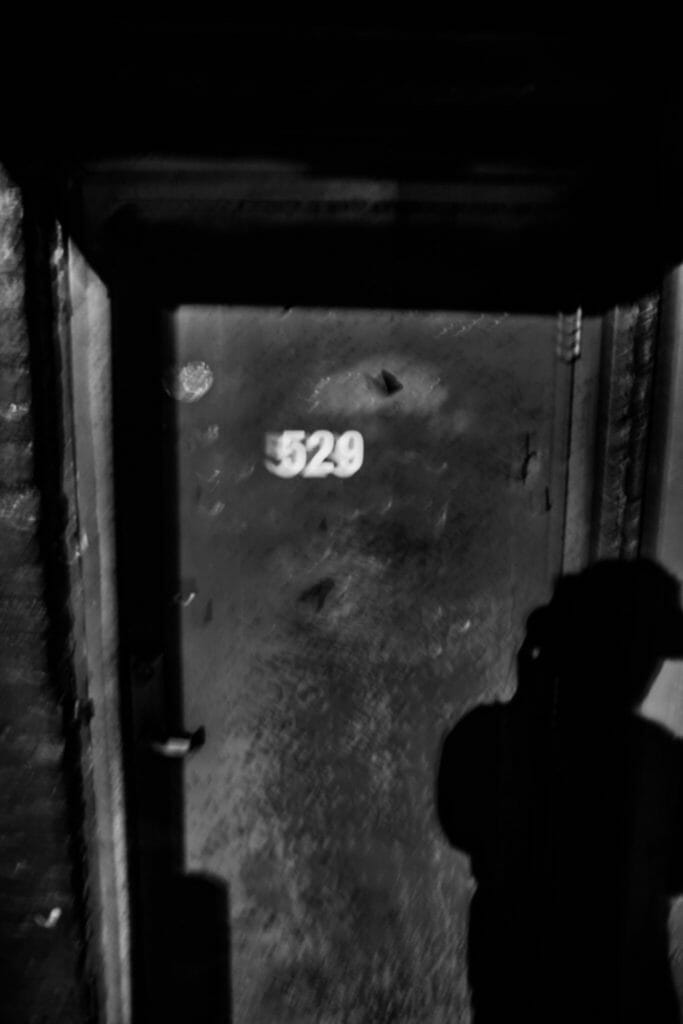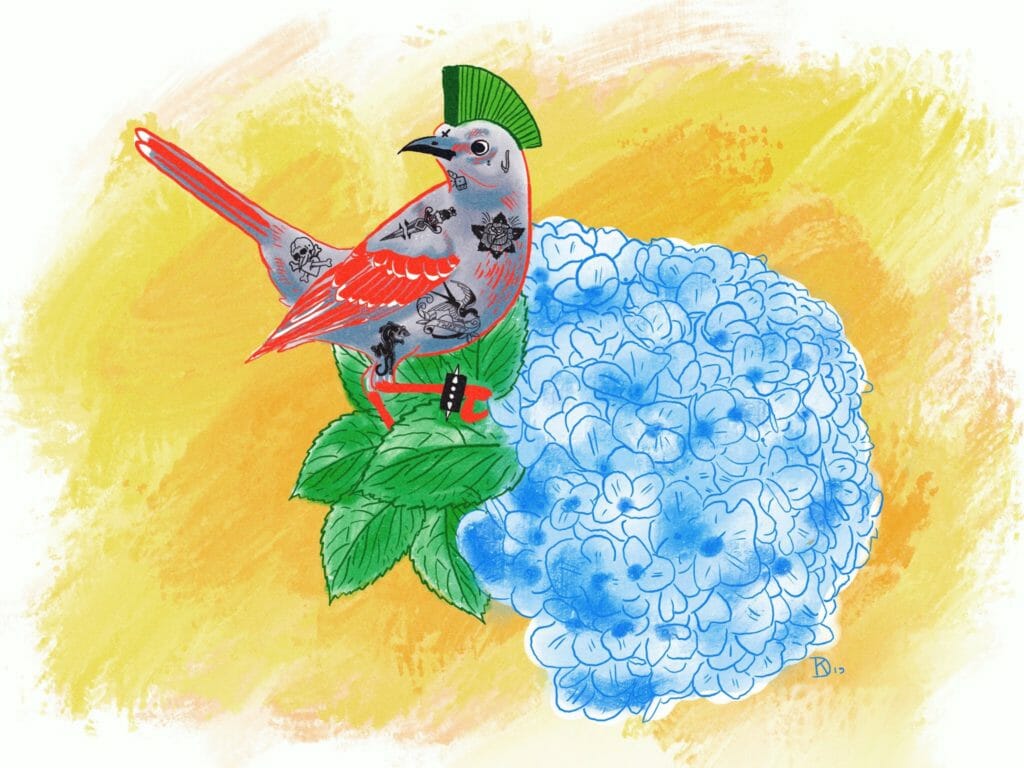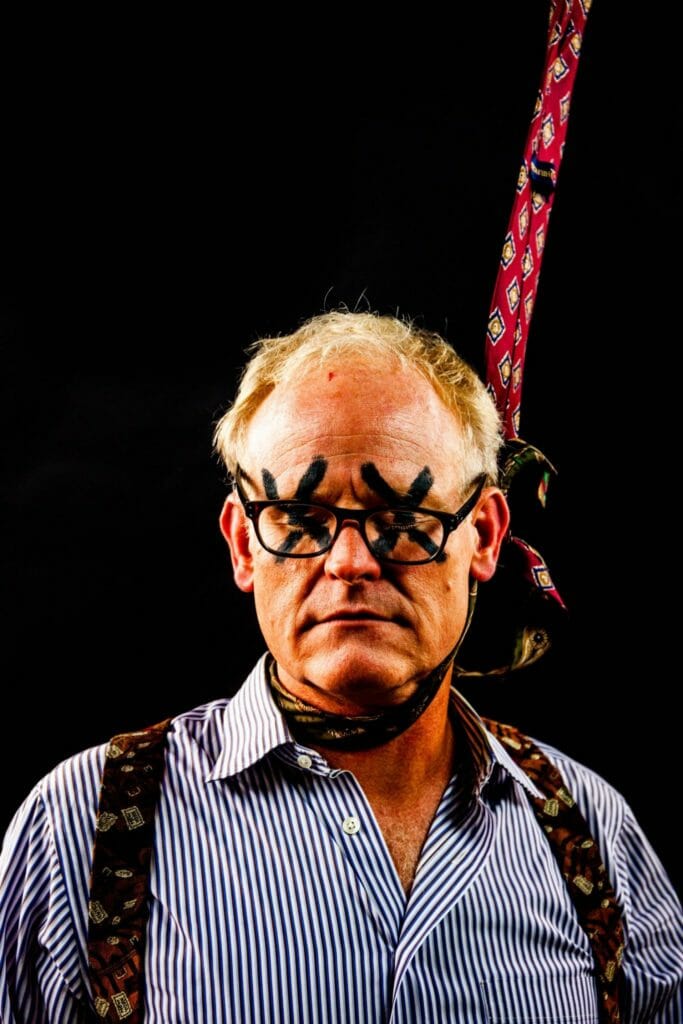“Too often, children are centered as decorative props or vulnerable protagonists in our political schema—serving as a receptacle for human futurity and a vehicle for public empathy. So, what does it really look like to center children in movement work as organizers, gatekeepers, and co-conspirators? The struggle to #StopCopCity has produced a diverse array of models for such collaborative efforts.”
– Ariana Brazier for Scalawag.
“Stop the greed! Save the trees!” shouted approximately 30 elementary school students as they marched in a loop around the second floor before spiraling down the large staircase in City Hall.
“No Trees, No Peace!” and “Save the Forest!” read the signs in colorful markers. The children had arrived eager and ready to demand that the adults in their lives stop Cop City.
Cop City is a now $109 million, 85-acre police military training facility slated for development in the Weelaunee Forest, the city’s last remaining large greenspace in predominantly low-income and Black, unincorporated DeKalb County. The proposal includes classrooms, burn towers, firing ranges, explosives testing areas, and a mock city to practice repression tactics. Protesting this proposal and the destruction of the forest, local children and their families have led marches and rallies through East Atlanta, toddlers have led impromptu rallies at their schools and provided offerings to the trees in the Weelaunee forest, and many families have spoken out at city council meetings.
Seeking to maintain the momentum, a new plan to center children in another direct action was formed last November as an exercise at the Direct Action Training for Families. The training was provided as a contribution to the Stop Cop City movement. During the training, the room was divided into two groups–one group proposed regularly scheduled picketing at the construction site, and the other group proposed a creative spectacle–bringing the Weelaunee Forest to City Hall. Or, as the shorthand title would become, Forest2CityHall. Specifically, everyone involved would speak on behalf of the trees on Dec. 4, 2023, the last city council meeting of the year.
While the Weelaunee Coalition would spearhead the action, the action attracted individuals from every corner of the movement, and even served as an entrypoint for some. The Weelaunee Coalition is a multi-racial, intergenerational group of educators, students, families and neighbors organizing to stop Cop City and protect the Weelaunee Forest (South River Forest). We ground our organizing in principles of radical solidarity with Black, brown and Indigenous liberation struggle.
With just under three weeks to plan and execute our demonstration, we moved expeditiously and advertised a call for families and artists. We wondered aloud about how to make the preparation for the action a collective effort.
First, we hosted an informational session to gauge interest and explain the logistical plan we developed. We also clarified the vision for the action, including how to manage potential risks. According to our plan, the participants dressed as trees would stand in the front of the room, closest to the city council members, putting them at a higher risk of arrest. (The Atlanta Police Department had already arrested activists indiscriminately for multiple nonviolent demonstrations throughout the years of the movement–for example, for flyering a neighborhood and attending a music festival.) Additionally, anticipating even more nuance, we explored what risks we could take while remaining child-centered. Everyone, trees included, were invited to read children’s books about respecting the earth during public comment. The trees would be both seen and heard!
During this planning session, a volunteer stepped up to be the “Lorax,” who would convene the other participants dressed as trees and coordinate their collective plan for the impending action. An initial dinner and craft meet-up was scheduled for the following week on Nov. 27. The next Monday at Park Avenue Baptist Church, we opened with food, followed with cooperative play, and began our due diligence on costume construction.
Thirty people, from toddlers to elders, stretched out across the room at tables and on floors to contrive their own tree or woodland creature from the communal craft materials, including cardboard, paints, fabric, and actual tree branches. Individuals came to the studio space throughout the week to continue working on their projects. They spent time with one another, fostering stronger relationships within the collective.
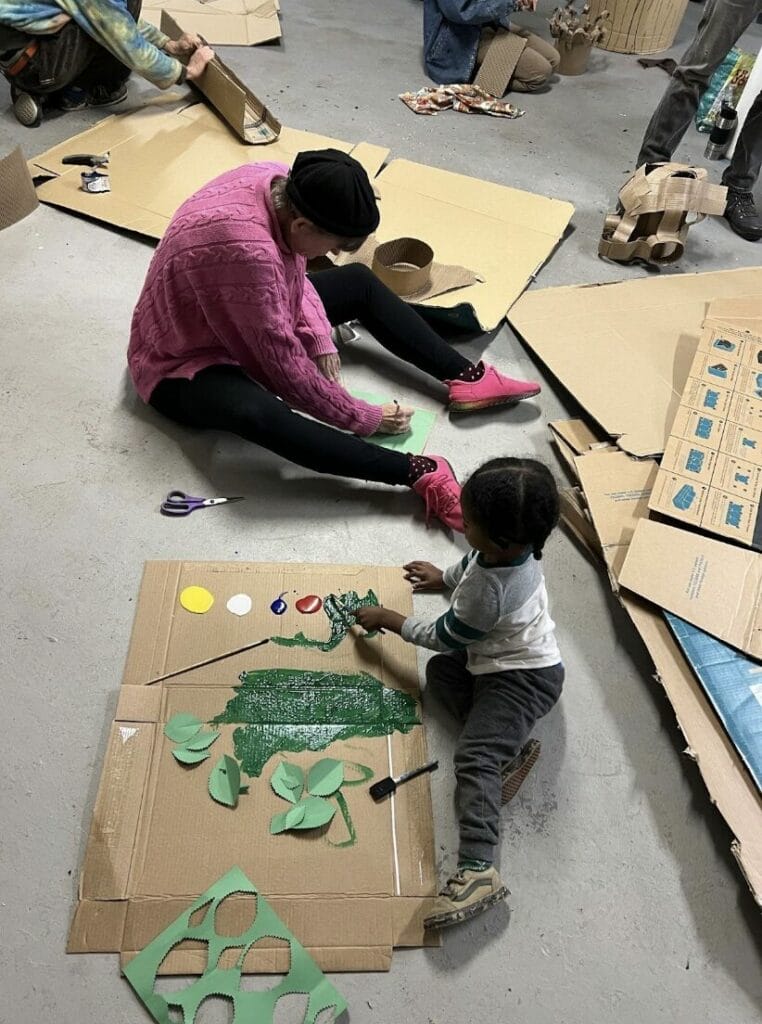
That Saturday, we met to rehearse our action. The agenda was set and shared in advance. At the meeting, we wanted to account for any gaps in our plan, like what could be made more efficient, who still needed support with their costumes, what books would we read during public comment? We had been advertising the action as a “field trip to city hall” and at least one school had made the preparation necessary to bring 30 students. What could they expect?
As we answered these questions, the room was electric. Participants were full of energy, asking rapid fire questions. Cross-talking and constructive dialogue ensued.
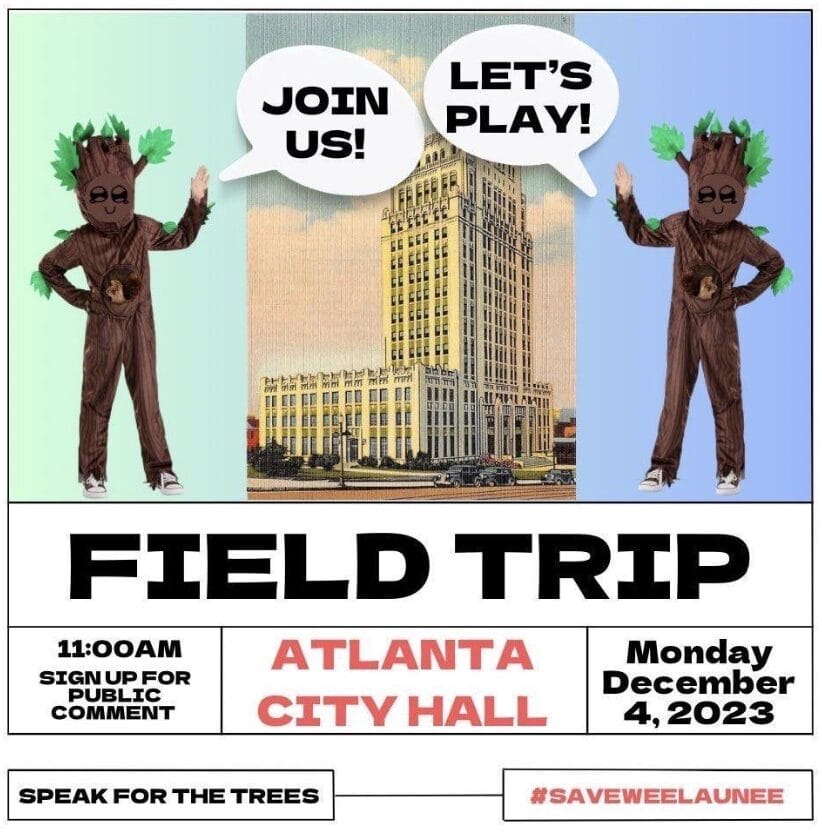
When Monday morning finally arrived, participants began pouring into City Hall at 11 a.m. as scheduled. Volunteers arrived early to set up activities, and a space with free zines, flyers, stickers, books and snacks.
At about 11:30 AM the children marched into City Hall. They dawned oversized Morgan Oliver School t-shirts, and as their line snaked up the stairs and around the corner, we could see the wreath of leaves in their hair and sticks in their hands. They had brought their classroom to the forest and the forest to City Hall just as we hoped.
The day proceeded along with the city council meeting agenda.
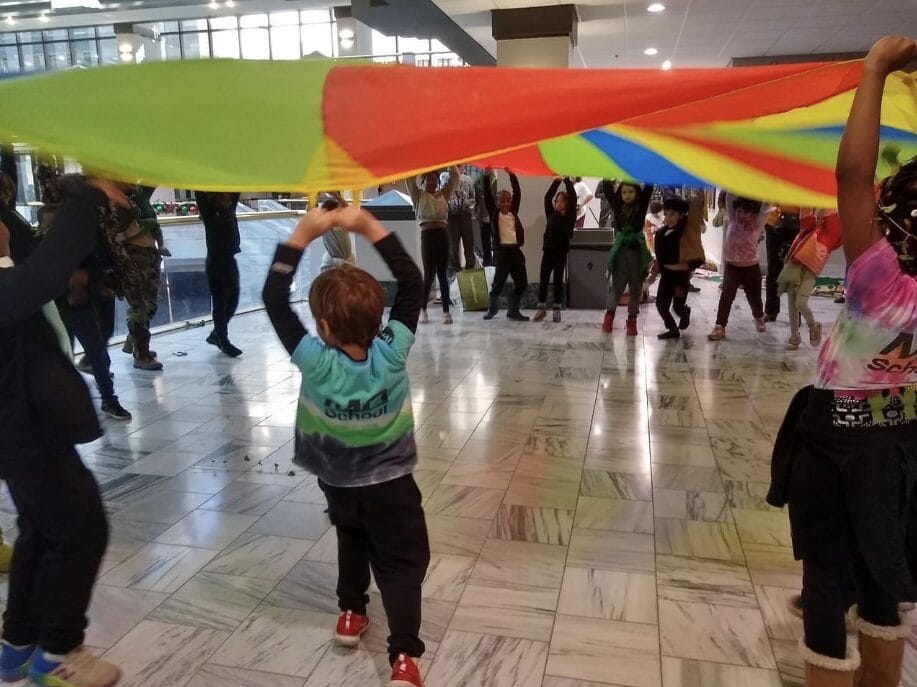
Minutes before the public comment portion began, the children lined up with their signage in hand and fake leaves in their hair. They readied themselves to march through the city council meeting behind the adults dressed like forest elements and wild animals. After marching quietly through the chamber during the proclamation and the pledge of allegiance, the Morgan Oliver students marched straight out of the chamber and through the first and second floors of the City Hall chanting, “No trees, No Peace!” and “Your choices impact us! Our voices matter!” They were raising their voices with chants of their own creation.
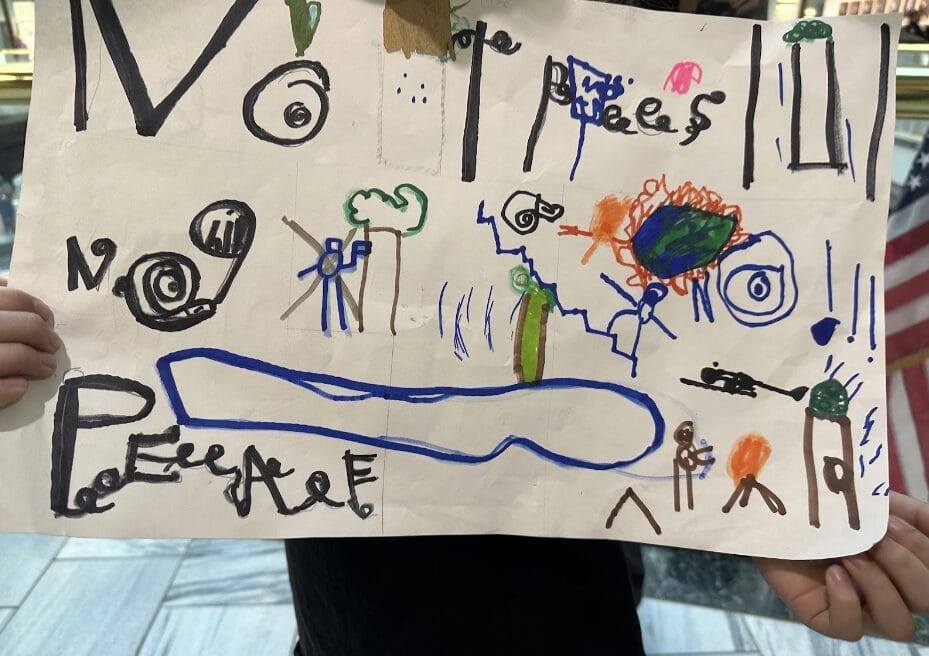
The shouts echoed through the building as adults took over public comments with picture books featuring narratives of social justice and earth stewardship–Lala’s Words, The Digger and the Flower, and We Are Water Protectors, for example. One person would read until time ran out, then hand the book off to the next assigned speaker who would finish the book with the time they had. One child read original writing about the need to stop Cop City and save the trees, and another read a zine they created. One child read a self-selected picture book, and another, who could not yet read, joined her mother at the podium. As each person and child read their portion of the story, the colorfully costumed adults stood directly behind the podium. The meeting was filled with brilliant color and many characters. One participant reflected that it was as if we had brought the picture books off the page.
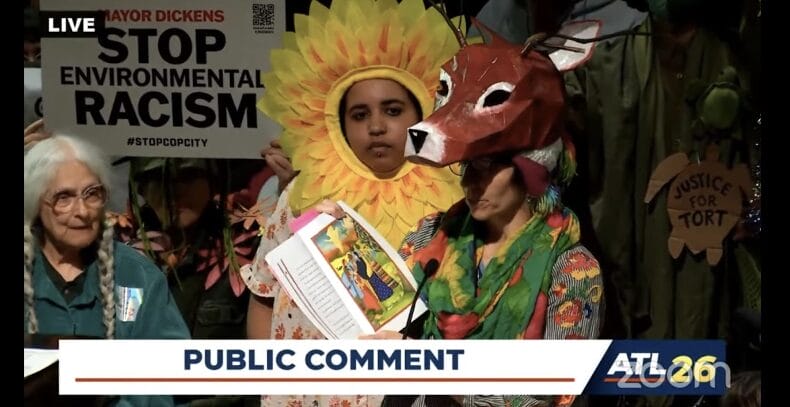
Unfortunately, this illustrative, animating scene was not enough to command even a morsel of attention from city council members. Many were on their phones, talking over and to each other, or half-dazed while people spoke and children read. Numerous seats were empty as their respective occupants were mysteriously absent. We later learned they were participating in a closed-door meeting, orchestrated by Mayor Andre Dickens’ representatives, to obstruct the impending proposal to move the referendum forward. The referendum is an initiative to put Cop City on the ballot and let voters decide whether or not the city should give its land to the Atlanta Police Foundation to build Cop City .
Despite the absences and negligences of our elected officials, the energy grew between protestors. The assertive voices, physical presence, and visual artistry of the impassioned children were the galvanizing forces.
The children were, in fact, community organizers and public educators. We had organized around their voices and desires they had expressed to save the trees. They wielded the absurd and cultivated chaos, channeling both productively to subvert formality and push boundaries in an ultimate effort to confront the bureaucracy. As one Morgan Oliver educator, Sky, noted: “No one uses chaos better than kids.” To that, I will add, no one is better equipped to challenge boundaries, render ridiculous our modus operandi, and sharpen the edges of our imaginations than kids.
Embodying the true nature of trees, the children stood their ground despite being surrounded by oppositional forces, and they introduced a breath of fresh air into the movement. Their presence created a circle of safety for the adults gathering around them and under their canopy, as it kept the police response minimal and distant.
Having multiple touchpoints, such as meetings centering play and crafting, in the build up to the city council meeting emphasized the necessity of each person and the role they fashioned for themselves. As a result, people experienced a sense of safety because they had been in joyful struggle together through competitive games and collaborative costume construction. Mainstream educational institutions will deny this, but people learn best when the content is personally relevant and viscerally experienced. As participants in this action, we were body-to-body at every stage. In this way, we were forming synaptic connections around each other, and rewiring our brains to see the movement differently because we recognized ourselves in the collective. Everything was now personally relevant—and therefore, political.
Even the parents and children whose initial touchpoint did not occur until they arrived at City Hall immediately experienced that safety, because we had equipped ourselves to extend it to them. The gravity and joy of children’s protest is universally intriguing and inviting in the way an opportunity to step through a time-portal back to our own childhood would be. (The parachute evoked much nostalgia from adults moving throughout City Hall, and became an irresistible reason to stop and inquire.)
Through their contribution to the Forest2CityHall action, the children reminded us that they are not only the seeds we must water for an abolitionist future, but they are also already fully formed trees, sheltering us from the danger of normality and formality, teaching us about the nature of grassroots collective action, and sustaining us for the crusade for our own lives.

